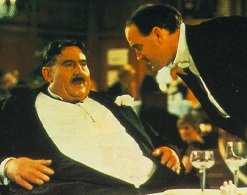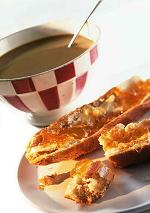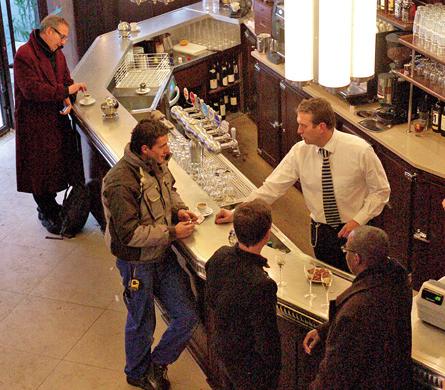Pause Gourmande
 Monday, May 17, 2010 at 10:39AM
Monday, May 17, 2010 at 10:39AM  Mr Creosote - Monty Python's ultimate gluttonA Gourmand or Gourmande, depending on if you are speaking to a man or a woman (the feminine form has an "e" at the end) can be gentle teasing way to call someone a glutton. A pause gourmande, pronounced Pose Gor-man-d, is a little gourmet break, a delightful snack. A good way, I think, to introduce a quick post about eating in France.
Mr Creosote - Monty Python's ultimate gluttonA Gourmand or Gourmande, depending on if you are speaking to a man or a woman (the feminine form has an "e" at the end) can be gentle teasing way to call someone a glutton. A pause gourmande, pronounced Pose Gor-man-d, is a little gourmet break, a delightful snack. A good way, I think, to introduce a quick post about eating in France.
I was having lunch with J recently and he noticed on the menu, hiding amongst the desserts, something called “Café Gourmand”. It was priced at 7€50, slightly less than the other desserts yet much more expensive than a coffee. Because he knew both meanings of Gourmand, he cynically joked that it was the owner who was the glutton, gouging the customers with his overpriced “gourmet” coffee.
In fact, this is a recent trend that has started to appear more commonly on Paris menus. A Café Gourmand is not an overpriced “gourmet” coffee, but three small desserts paired with a little espresso. Or for those in the know, a Noisette. A great guilt-free dessert where you often get to sample three mini-versions of the desserts on the menu. It’s the perfect end to a nice lunch and ensures you get “just a bite” of dessert without having to cajole your friends into ordering a full dessert to share.
During the course of another lunch, with MC, a close friend who frequently inspires my posts, we talked about table manners. Her French husband is quite a stickler for the rules, even though he breaks them with abandon himself. He shrugs off protests from his family with the classic comment “its okay to break the rules as long as you know what they are”
We were having Terrine de Fois Gras, a chilled version of Fois Gras, usually served with little Brioche toast points and some sort of sweet relish. That day it was a mild Mango Chutney. As we ate the Fois Gras, MC explained to the others at the table the proper way to eat such a dish. Voila, more rules about eating in France. You see, there is a tendency for people to spread the creamy rich fois gras on the toast point and then happily eat it like a breakfast Tartine, akin to an open-faced peanut butter sandwich.
The word tartine (Tar-Teen), comes from the verb tartiner (Tar-Teen-Ay) which means to spread. A Tartine is a 3-4 inch long half baguette spread generously with butter and sometimes jam too - if you are a gourmande. This is dipped in the bowl of coffee for breakfast. Well, just like a big milky coffee, that’s the end of “tartines “ – “spreading” for the day.
Here’s the rule, aside from breakfast you should never - tartinez- at the table. So, taking a big chunk of Fois Gras and spreading it all over the toast to make a sandwich is not correct. With the tip of your knife, you pick up just enough Fois Gras for one bite and you put this on the corner of the toast. Then you take a bite of the toast along with the morsel of Fois Gras. Then savor the perfect bite...
I already knew this rule about Fois Gras, but MC called me out a bit later when I was liberally spreading the amazing Bordier Smoked Salt Butter all over a piece of bread. It turns out that the rule “No spreading after breakfast” applies to butter as well. You are expected to put just enough butter for one bite and never to spread the entire piece of bread with butter, take a bite and set the rest down on your bread plate. Well, on the table actually.
That is another odd thing; if you have been to France you know there is almost never a bread plate. Once you have taken a piece of bread, between bites you set it directly on the table to the left of your plate. This is probably because that the French use bread the way the rest of us use a knife so it rarely gets put down. Any time you need to push something onto your fork it is more polite to use the bread than a knife. Most important of all, you must never “sauce” with bread. This is using the bread like a sponge to wipe up any remaining sauce and pop it into your mouth - Very tempting with most French sauces. One exception, allowed only at home, is to spear your bread with the fork and “Sauce” using your fork to hold the bread.
The last and most counter-intuitive point in French table manners is that you are never allowed to put your hands in your lap during a meal. I had heard this early on, but didn’t really believe that this could be considered impolite. After all, I’d been badgered in the opposite direction for years as a child.
One day over lunch with Jacqueline, a very feisty friend in her seventies, who I consider to be my French Grandmother. At a moment between courses, I placed my hands politely in my lap. Hey, she said “Qu’est-ce tu fais là-bas” essentially, “What are you doing down there”? A bit embarrassed at being accused of who-knows-what, I put my hands above the table. No elbows, just the forearms and hands. “C’est mieux” – “That’s better” she said and we resumed our conversation.
 "Souper chez le Prince de Conti", 1766 by Michel Barthélémy OllivierI don’t know the origins of this rule come but one imagines the famous intrigues of “Les Liaisons Dangereuses” and other clandestine love affairs between gentlemen and their mistresses. Affairs that went on under the noses of husbands and wives, perhaps at dinners with all parties present. In such a case it would be very important to know what people were up to “under the table.”
"Souper chez le Prince de Conti", 1766 by Michel Barthélémy OllivierI don’t know the origins of this rule come but one imagines the famous intrigues of “Les Liaisons Dangereuses” and other clandestine love affairs between gentlemen and their mistresses. Affairs that went on under the noses of husbands and wives, perhaps at dinners with all parties present. In such a case it would be very important to know what people were up to “under the table.”
In the immortal words of Julia Child, a fellow alum from the Cordon Bleu Cooking School - "Bon Apétit!"
 Coffee,
Coffee,  French life in
French life in  Family Dining,
Family Dining,  Food,
Food,  French Culture,
French Culture,  Practical Paris
Practical Paris 


